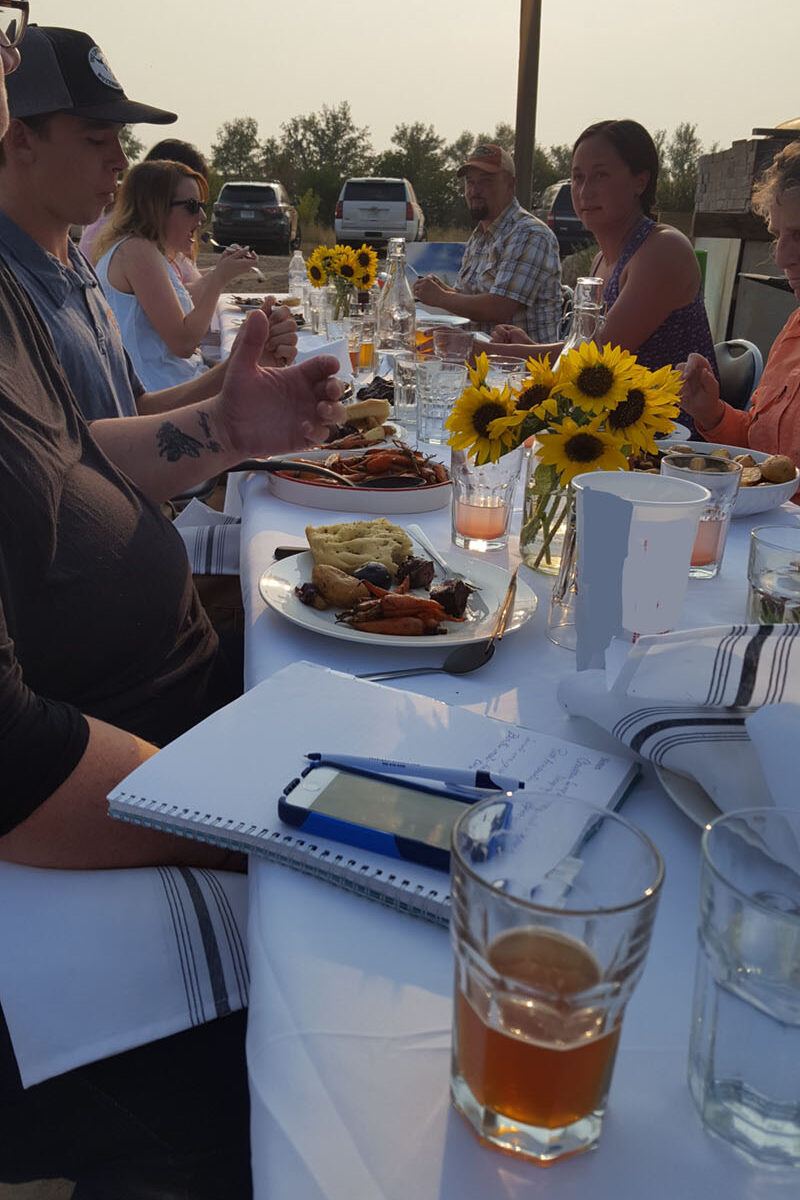
Farmers and ranchers are well known for having a strong sense of community. We usually think of community in terms of our neighbors. However, the value of community in our lives as both farmers and business owners goes beyond the people who live in the same place as us. “Community” can mean our neighbors, but it can also include people who live far away and those who share the same background, interests, or experiences.
In agriculture as in life, community can exist at various economic, geographic, political, cultural and social levels. Perhaps there are other farmers in your area who might be interested in marketing cooperatively to improve sales. What about other farmers you might chat with or follow on social media and who share your philosophy about farming practices and are a source of advice? Who else in your town might get equally riled up as you do about changes to zoning laws? How can you engage with your non-farming neighbors in a positive way that earns their respect and support for the contributions you make to the community? These are all examples of ways to think about community and how community can improve both the sustainability of your operation and the health of the community where you live.
Farmers in Montana are taking a grassroots, values-based approach to strengthening regional food economies through a project called the Montana Food Economy Initiative. Organized by the nonprofit Alternative Energy Resources Organization (AERO) and funded by two SARE grants (OW17-026 and RGR20-009), the project has brought together stakeholders to create strategic plans for growing the local food economy in four regions of the state. By their estimates, replacing 15% of out-of-state agricultural products with in-state products could generate $134 million of new income for Montana’s farmers. In such an ambitious project, AERO has discovered that relationships are vital to success, and that cultivating them takes time.
“It helps to have—and commit to—real relationships in a community to facilitate this type of work,” says AERO Co-Executive Director Lindsay Ganong. “An authentic interest and willingness to learn new things about a community and the people there, as well as openness to adjust how you do things, is vital.”
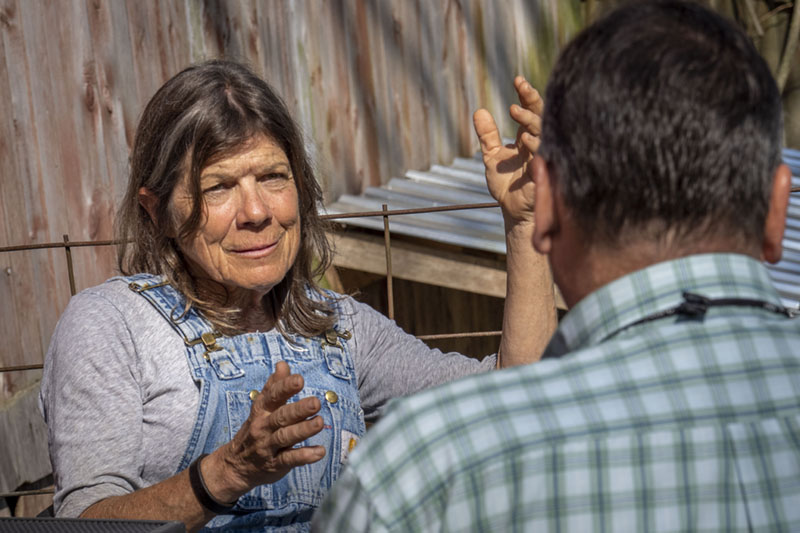
The Value of Community Capital
In economics, the term capital generally refers to financial assets that businesses can draw on to support their operations and produce something to sell. Social scientists, however, use the term capital much more broadly, referring to what are known as community capitals to help build community. Community capitals are like financial capital in that they represent assets that can help you and your business thrive. These forms of capital are available to all farmers to varying degrees, and they are particularly useful in communities with a deficit of financial and built (infrastructure) capital; such areas are likely to exhibit greater levels of poverty and inequality, and may need to rely more on social and human forms of capital.
Different types of community capital include:
- Human. The wide collection of skills and information embodied in a community that can be applied to community needs. One way you can invest in human capital is by hiring local teenagers for certain jobs and providing them with opportunities to build up their farming skills. Not only can you cultivate talented labor, you help ensure the next generation will want to remain within farming communities.
- Social. The social relationships shaped by bonds between individuals and among groups that can be drawn on for information and assistance. Trusting relationships developed over time enable community members to cooperate more effectively to set and pursue shared goals or respond to problems.
- Natural. Natural resources found in a community, such as land, water and soil. Healthy ecosystems benefit the whole community by being more resilient, more attractive and better for health.
- Built. The infrastructure and facilities available to a community, such as transportation, telecommunications or industry. Equitable access to a wide array of well-maintained infrastructure is essential to the economic health of a community.
- Cultural. The worldview and traditions that shape how a community interacts and the perceptions, goals and motivations of its members. Shared values of sustainability, fairness and service can lead to many positive changes in a community.
- Political. Access to policy decision making with people in positions of power and authority. Policymakers make better decisions when more people can communicate their diverse, on-the-ground perspectives and priorities.
Connections on the Farm and Ranch
Key to community connections is the process of building and maintaining the relationships, shared values and institutions that help create and maintain community.
In agriculture, community connections focus on the quality of relationships among farmers and between farmers and the non-farming communities in which they live (people for whom agricultural interests and values might be important but are not of the highest importance in their daily lives). These relationships occur at many levels. For example:
- A sense of place. Do you feel that you belong in your community? Do you have a positive attachment to your community, socially and culturally? Do you have mostly positive interactions with others in your community? For example, learning about the natural and human history of your area might motivate you to engage with others to enact positive change, such as efforts to preserve your local environment, history and culture, and this can contribute to a sense of personal fulfillment.
- Civic engagement. Are you able to contribute to local organizations and/or services? Can you participate in local activities and community life? Can you influence how agriculture is incorporated into your town’s master plan? Is there active participation via social interactions and social networks in your community? Participating in local advisory boards, agricultural associations or public meetings can empower you, which makes you feel like you have a voice on issues that affect you but might otherwise feel like they’re beyond your control.
- Regional presence of agriculture. How much other agriculture is there in your region? Is all of the food produced being exported or can you obtain much of your food locally or regionally? Can it be promoted? For example, in western North Carolina, the Appalachian Sustainable Agriculture Project has engaged in long-term efforts to promote local foods as a way of creating new opportunities for area farmers who struggle with commodity markets.
- Community pride. Do you have pride in your community? Does your community band together to support each other when some or all are faced with hard times? For example, in response to the economic and supply chain turmoil caused by the COVID-19 pandemic, a group of Midwestern commodity farmers began devoting some of their acreage to “chaos gardens.” With minimal effort, they planted vegetables as cover crops that local food banks and members of the community were invited to harvest.
- Community stability and safety. Do you feel free and safe to interact with and participate in the community? Is your community mostly free of crime and disorder, or are agricultural crimes common, such as property damage or theft of valuable livestock, machinery, supplies or crops?
- Shared understanding. Is there a shared understanding between farmers and the community about what happens on farms? Are neighbor relations positive? Does your community see farming as part of the local culture? Engaging with the community at large, be it through local marketing or through participation in local government and public events, is an effective way of sharing with others both your personal values and your value to the community.
- Equity. Does your community have local access to information, inputs and expertise? Do all citizens/farmers have equal access to financial and social resources? For example, is there broadband access planning in your community, and does it provide opportunities for farmers and agriculture? Or, are there farmers in your community whose first language isn’t English, and are there resources available to help them access information that is available to native speakers?
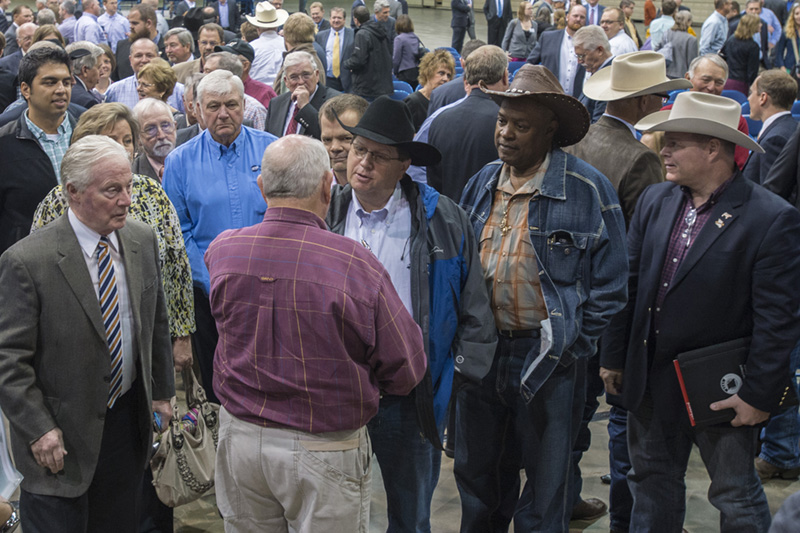
Social Relationships and Shared Values
Strong social networks between peers, fellow community members and those who work with farmers help support farm businesses and the families that rely on them.
Beyond having a positive impact on health and wellbeing, research also suggests that strong community connections lead to enhanced economic development and improved democracy. Recognizing the role that strong relationships play in advancing their cause, the AERO project in Montana includes an intensive training program for producers and agriculture professionals to develop their coalition-building skills and improve their ability to lead local food initiatives.
Social networks can take many forms, and while social media is one of them, we are talking about much more than that. The form they take and the value they provide can vary depending on whom you are trying to connect with, where they are located and why you’re connecting. If you’re an educator, understanding the needs and strengths of these networks can help you provide better support to your farmer clients.
Farmer-to-Farmer Social Networks
Connecting with other farmers is a powerful way to improve your own farming practices, gain new business opportunities, create a more favorable public environment for farming, respond to unexpected challenges and increase your sense of fulfillment. Consider the many ways you can create or join both formal and informal farmer-to-farmer networks.
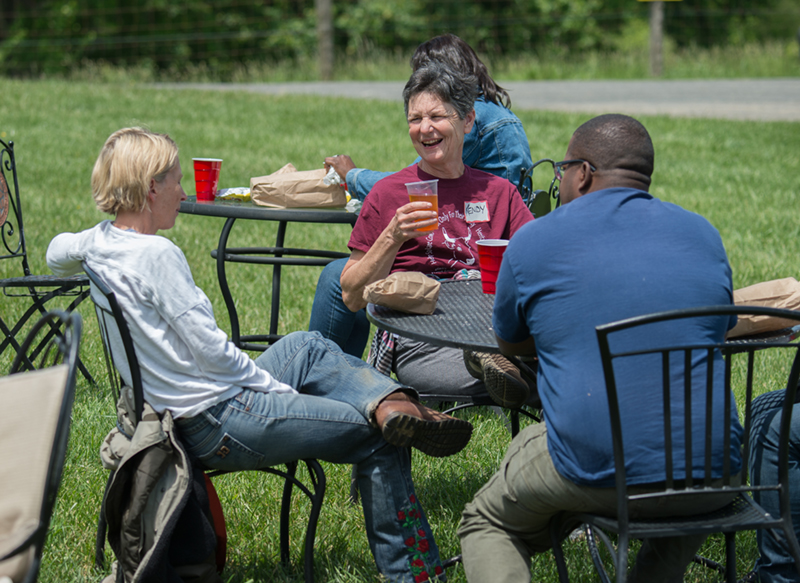
Peer networks. Peer networks might include learning circles or farmer meetings, and they can be used to share information and socialize. Basically, they are any loosely structured educational event, often focused on a specific topic, that allows farmers to learn from each other. They are especially helpful in a local setting and for beginning or young farmers. Existing networks should include a formal or informal mechanism to find and welcome in new farmers. Just as increasing biodiversity is a time-tested way to make a farm more resilient, striving for a diverse network of people will bring you more experiences, perspectives and ideas that help you when solving problems or pursuing new opportunities.
In Minnesota, the Hmong American Partnership and University of Minnesota (UMN) Extension partnered with an advisory board of Hmong farmers to organize farmer-to-farmer outreach on the topic of on-farm food safety Good Agricultural Practices (GAPs), in a project funded by a SARE grant (ONC16-016). The group learned that the key to a successful peer-to-peer project was to focus first on those farmers who are most motivated to engage, and then let them become mentors to others over time. In this case, it was a handful of farmers who wanted to scale up to wholesale markets, where GAP documentation is usually required.
Many who sell at farmers markets care about food safety in general but not enough to develop a food safety plan or even attend a workshop. The peer mentors are now able to offer this information to their peer farmers, encouraging them to attend a food safety workshop or field day led by the mentors.”
UMN Food Safety Educator Annalisa Hultberg
Conferences and meetings. In-person events are not only a great place to learn about new techniques and equipment, they’re also valuable for networking, socializing and expanding your horizons. These events are typically organized around a shared value or identity of some kind that can cross political and other divides, such as organic production, women farmers or a particular commodity. This gives them the potential to build dialog around other issues that attendees might view differently.
Farmer-to-Community Social Networks
Today, many farmers and their non-farming neighbors lack a shared sense of identity, especially in rural areas that are seeing population growth driven by the arrival of exurban, non-farming residents. This can lead to misunderstandings and less community solidarity, but the trend can also be reversed when people in the community see the positive role farming can play in their own quality of life.
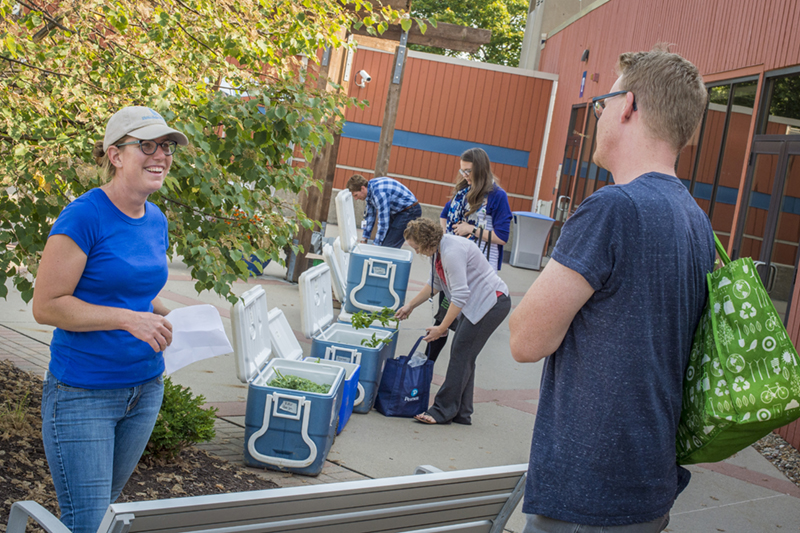
Fostering a positive relationship with the community commonly involves activities like agritourism or public events, direct marketing or social media efforts. First, you should have a sound marketing plan in place to ensure any investment you make in this area is likely to provide a good financial return. Part of a good plan is having appropriate marketing materials that share your personal and farming values with the public to help them understand and appreciate your work, and even see themselves in it.
Not only can you create new income streams from activities like U-pick, farmers markets, farm dinners or harvest festivals, you’re also educating the public on “where their food comes from” and providing them an opportunity to participate in it. Raising awareness of farming activities may help solidify positive community attitudes toward agriculture within your region, and it can turn the general public into advocates for issues that are important to you.
For Shakera and Juan Raygoza of Terra Preta Farm in Edinburg, Texas, community support was vital to allowing them to put high tunnels on their land. They’ve gained a presence in the community through their CSA and farmers market customers, by hosting field trips and allowing families to visit the farm on weekends, and by working with the local university on beginning farmer training programs. At first, local zoning laws prohibited the Raygozas from building high tunnels within the city limits, but through extensive petitioning from their supporters and with some favorable media coverage, they were able to convince local officials to grant them an exemption.
“We support our community, and they showed up for us. And now they’re reaping the benefits of all the produce we’re growing [in our high tunnels].”
Shakera Raygoza of Terra Preta Farm
Hear their story in their own words at www.sare.org/terra-preta-community.
You can take positive community relations a step further by partnering with local educators, nonprofits and other farmers in local or regional initiatives that address environmental stewardship or public health. Look out for local watershed conservancies, youth education programs or groups that support food-insecure families, to name a few. One example is the New-Mexico-based Quivira Coalition, a coalition of farmers, ranchers, conservationists, land managers and others that promotes agricultural practices that are both profitable and ecologically sound.
Cooperative Development
The cooperative (or co-op) is a unique business model in which the farmers who use its services are its collective owners and decision makers, meaning individual members share in its financial value and have a voice in its management. Like its name suggests, a co-op offers the benefits of cooperation among farmers as opposed to the drawbacks of competition. Cooperatives have been around for more than 200 years, and they remain an effective tool for farmers to assert themselves in the food supply chain by working together.
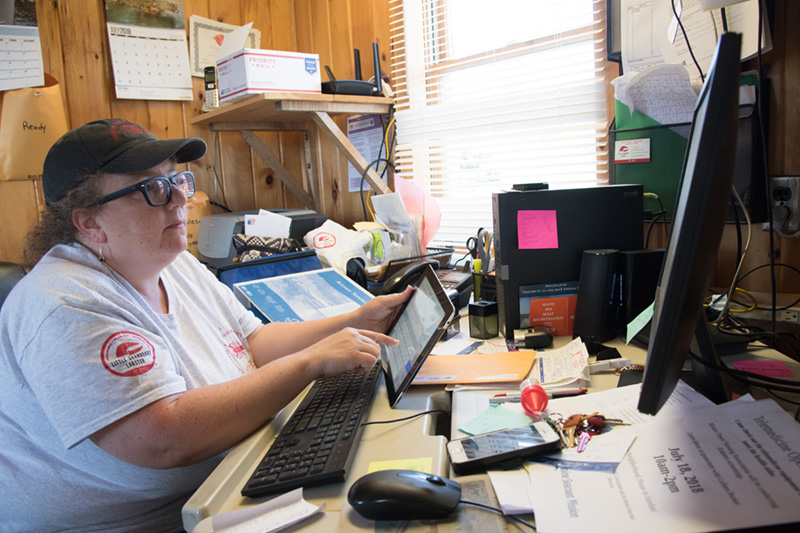
When you join a cooperative or form one with a group of other farmers, you can begin buying supplies or services and selling products at a higher volume, which gives the cooperative more leverage to negotiate better prices and terms from large corporate suppliers, distributors and retailers. In many cases, a cooperative will create its own capacity to fulfill certain production, processing, distribution or marketing needs instead of paying another company to do so (for example, by investing in shared farm equipment and hiring staff to use it or by building facilities for processing and packing). By scaling up and expanding its activities through more of the supply chain, a cooperative allows its members to more efficiently capture the economic value of the food they’re producing.
This can have a spillover benefit to the entire community. Not only can individual farmers keep and invest more food production dollars in their own community, the cooperative itself pays local taxes and oftentimes creates jobs. Because small cooperatives are locally owned and collectively managed, the jobs and tax revenue they provide are more durable than other kinds of businesses. Whereas a corporate business can easily leave town because of a decision by a single person or a small leadership team, a cooperative is owned by all of its members and is thus rooted in its community.
Cooperatives also provide farmers the opportunity to amplify their voices. Many cooperatives engage in political advocacy on issues that affect its members, and, for the same reason it has more clout in the marketplace because of its scale, it can be more effective at influencing policy because it represents many voters. In fact, cooperatives sometimes collaborate with other cooperatives or with trade organizations for greater impact.
Eye on Equity: Community Connections
Implicit in the idea of community is that everyone belongs and has something to offer. This means casting a specific eye toward inclusion and equity at every level of community. How are marginalized farmworkers and community members treated? Does the community make an effort to include them in the local culture, or are they relegated to the outskirts? Are farmworkers treated fairly with livable wages and adequate housing? As farmers grow increasingly diverse in terms of age, background, gender, sexual identity and race, are all farmers made to feel welcome and provided with adaptable accommodations in agricultural networks, tours, workshops, meetings and other communal spaces? A community cannot be truly sustainable if some of its members lack equal access to adequate housing, food, education and support services.
Diversity is a critical theme throughout all of sustainable agriculture, whether it is ecological diversity across the farm landscape, biodiversity in the soil or human diversity in our communities. Just as we understand and appreciate the importance of maintaining soil that is teeming with many kinds of life, all healthy and working to help you grow a good crop, in our communities we all benefit from different ideas, voices and practices leading to innovation and the overall strength of the community.
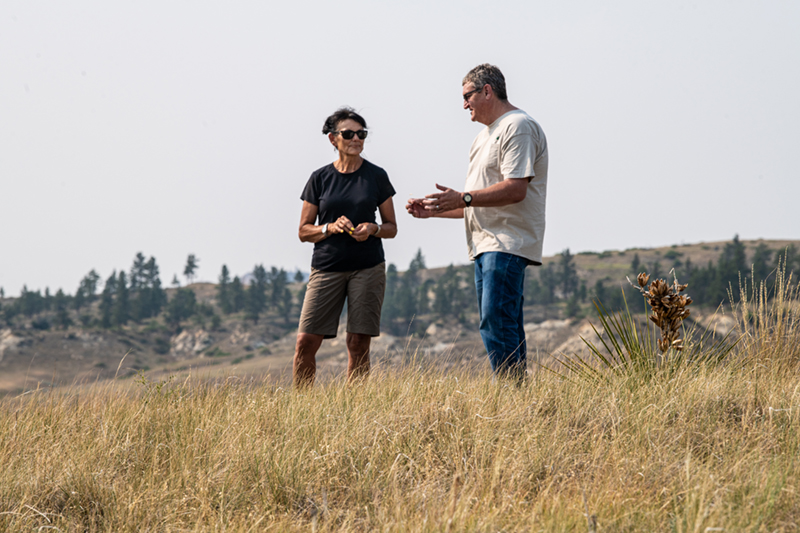
Effective Outreach to Targeted Groups
For agricultural educators, there are certain principles of adult learning to bear in mind when delivering effective programming for farmer constituents, according to the guide Sustainable Agriculture Through Sustainable Learning: An Educator's Guide to Best Practices for Adult Learning. These principles are rooted in cognitive science, and they have particular importance when engaging with producer groups who identify as women, are immigrants, speak limited English, or are people of color. They include:
- Create a safe, nonjudgmental space for learning. This concept is based on science that suggests the brain is more receptive when a person is experiencing positive emotions such as joy or surprise, and it is unreceptive when negative emotions are felt, such as anger or fear.
- Understand your audience well enough to make content relatable to them. The brain processes new information more effectively when it has prior knowledge or experience it can relate this information to.
- Identify any existing knowledge and implicit biases your audience (or you) might have toward the topic. Implicit bias happens when the brain processes new information by relating it to similar existing knowledge. While this is an efficient way to create memories and knowledge, it also causes the brain to make assumptions about a new situation without fully taking into account all of its unique characteristics. This happens to all of us in one way or another, and biases can be an impediment to learning if they are not identified and addressed in some way.
Learn more from Sustainable Agriculture Through Sustainable Learning: An Educator's Guide to Best Practices for Adult Learning.
Women farmers. U.S. agriculture has traditionally been a male-dominated profession, but as women gain more prominence as farmers, ranchers and agricultural landowners, targeted outreach to them is increasingly important. Many women producers report that they value women-only learning events and networking opportunities. The intention is not to exclude men from important conversations. Rather, it’s to take advantage of the principle that adults learn and engage better in comfortable spaces, and women who participate in women-only events regularly report they feel more willing and able to engage with the subject matter and to share their experiences with other participants.
There are many examples of this approach being used successfully. Annie’s Project is a risk-management curriculum for women in agriculture that has been offered in 33 states. The Women Food & Ag Network and American Farmland Trust (AFT) collaborate to offer “learning circles” designed to help woman-identifying landowners and producers improve their conservation practices through information sharing and networking (ttps://wfan.org/women-caring-for-the-land). AFT reports that more than 70% of women who participate go on to take action toward improved conservation on their land.
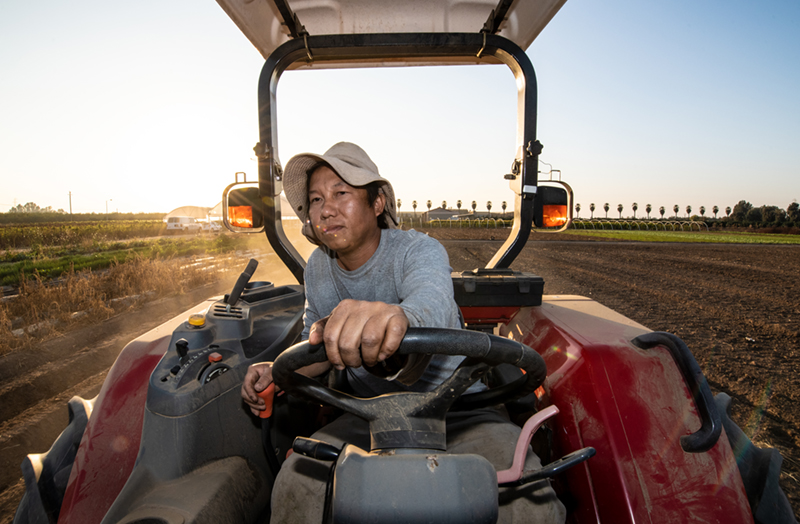
Working Across Diverse Cultures
To help diverse cultural groups thrive in agriculture, service providers oftentimes need to develop skills, perspectives and partnerships that go beyond what they use in their typical outreach. According to the Journal of Extension article, Facing Issues of Diversity: Rebirthing the Extension Service (Schauber and Castania), the personal skills needed to navigate and communicate across cultural differences include:
- An awareness of one's own cultural communication style, which reflects one's perceptions, assumptions, norms, beliefs and values
- An awareness of other valid cultural communication styles, which reflect different perceptions, assumptions, norms, beliefs and values
- An understanding of historical power differences and the present-day behaviors that result from the history of a group's survival
- The ability to empathize cross-culturally, to take multiple perspectives, to observe mindfully while reserving judgments and to adapt one's communication style to others.
Some steps that educators can take to improve their service to culturally diverse groups include providing diversity skills training for staff, hiring professionals who have these skills and/or represent different cultures, and encouraging partnerships with organizations that have established relationships with and understanding of the communities they are trying to reach.
Hispanic and Latino farmers. The number of farms with a principal operator who identifies as Hispanic or Latino increased 53% from 2002 to 2017, according to the U.S. Census of Agriculture. The members of this broad farming community are quite diverse; it can include immigrants, multigenerational Americans, professionals who recently became farmers, farmers with extensive agricultural experience, and farmers with varying proficiency in English and Spanish. Many of these farmers face myriad barriers to accessing information and services provided by educators. These barriers may include language or immigration status, but beyond that, even U.S.-born Hispanic and Latino farmers can be challenging to reach due to a suspicion of government or because service providers lack a connection to their cultural values or communities. The inconvenience of attending outreach events and multiple demands on time can be other difficulties.
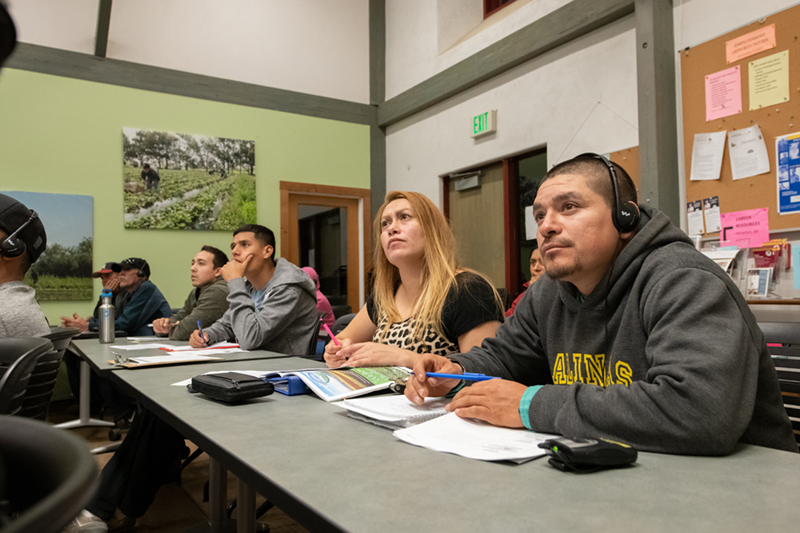
In Pennsylvania, horticulture professor Elsa Sanchez organized a series of workshops to help her Extension colleagues improve their ability to work with Hispanic farmers, one of the fastest growing and often underserved farmer demographics in their state. The workshops, funded through a 2015 SARE grant (ENE15-139), included an expert on the science of inclusion, a Latino community studies specialist and representatives from organizations with a long history of serving Hispanic farmers. Some of the programming ideas that came out of the series included:
- Build trust and personal relationships to improve the comfort level of Hispanic and Latino farmers/farmworkers.
- Provide transportation and involve families.
- Contact community groups to help identify and work with farmers/farmworkers.
- Contact employers of farmworkers and communicate to them the value of educational programs for farmworkers.
- Use interpreters and translators.
- Provide childcare or an activity for kids who are attending events with caregivers.
- Learn Spanish, even if it’s broken Spanish.
- Hire a staff person who is dedicated to outreach to Hispanic and Latino communities.
The University of Vermont Extension’s Farming Across Cultures includes information and resources to help farmers improve cultural awareness and communication when working with Latino employees.
Native American communities. Native American and Native Alaskan tribes are recognized by the United States as sovereign nations with their own systems of self governance. (Notably, though, Native Hawaiians and other Pacific Islanders do not have federal recognition.) Today, there are many examples of Native American communities working in culturally relevant ways to improve natural resource stewardship, economic conditions and quality of life for their members. In many cases, these efforts are in collaboration with technical specialists at universities and with local, state and federal agencies. A few include:
- The Native American Rangeland Partnership is a collaboration between Western tribes, the NRCS, the U.S. Forest Service and others; its goal is to provide high quality, culturally relevant training to tribal rangeland managers.
- The Blackfeet Indian Reservation used a SARE grant (EW18-027) to improve the internal capacity of its employees who manage the reservation’s agricultural resource management plan, a blueprint for using, protecting, conserving and restoring the tribe’s agricultural lands.
- Many of Alaska’s federally recognized tribes and its 12 regional Alaska Native corporations—which together are the state’s largest private landowners—have partnered with the NRCS to establish tribal conservation districts. These districts are able to combine local and traditional knowledge with technical resources to actively manage natural resources in a way that achieves goals in subsistence, economic opportunity, resource development and cultural preservation.
- In 2018, Michigan educators formed the Michigan Inter-Tribal Land-Grant Extension System (MILES) to help Extension make inroads with local tribes. The team consists of Extension staff from its 1862 land-grant university and its three 1994 colleges, and they collaborate with tribal leaders and each other to provide culturally appropriate support for the 12 sovereign tribal nations located in Michigan.
At the same time, there are very few Extension agents serving Native American tribes through the Federally-Recognized Tribes Extension Program (FRTEP). A 2016 review of FRTEP resources estimated that while there is an average of three agents per county across the United States, there is an average of 0.1 agents per reservation. Similarly, the system of tribal colleges and universities (1994 land-grant institutions) provides research, education and Extension programming to tribal communities, but with very limited resources.
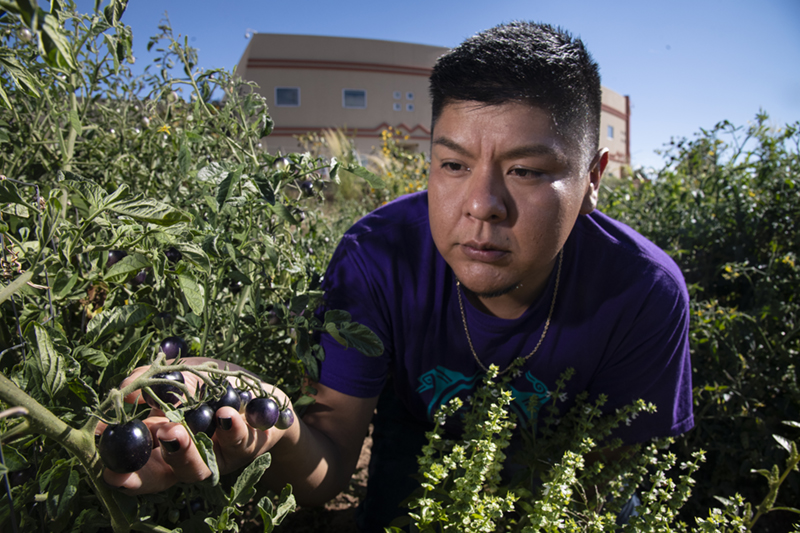
Agricultural professionals seeking to work with tribal communities in their area should be aware there are significant differences compared to working with their usual clientele. Extra effort needs to be made to overcome distrust by learning the cultural values of a tribe and taking steps to build relationships. You also need to have a solid grasp of how land tenure issues, tribal governance, traditional knowledge and cultural values influence the management of land and risk in order to provide effective support in the areas of research and education. According to the Western Extension Risk Management Education Center, “Long-held and long-practiced tribal cultural beliefs may be intricately intertwined with on-the-ground ranching and farming practices. Tribal members often identify cultural aspects of their life as much more important than their financial or economic health.”
Low Income Communities and Local Foods
Local food systems contribute to the two-way street of farmers supporting the community and vice versa, but often many members of the community may not have access to local food because of a reduced income or because they live in neighborhoods that aren’t served by farmers markets. At the same time, many farmers who sell locally already have a low profit margin and can’t afford to lower their prices to a point that low-income families can afford.
Leah Penniman and the team at Soul Fire Farm in Grafton, N.Y., who are recognized nationally as leaders in food justice for getting fresh food and farming opportunities to those who are usually left out, decided to tackle this problem with a SARE grant (FNE17-879). Seeking to reach low-income consumers and communities while maintaining a financially viable farm business, Penniman and her team worked to identify and promote best practices for farmers hoping to reach low-income communities.
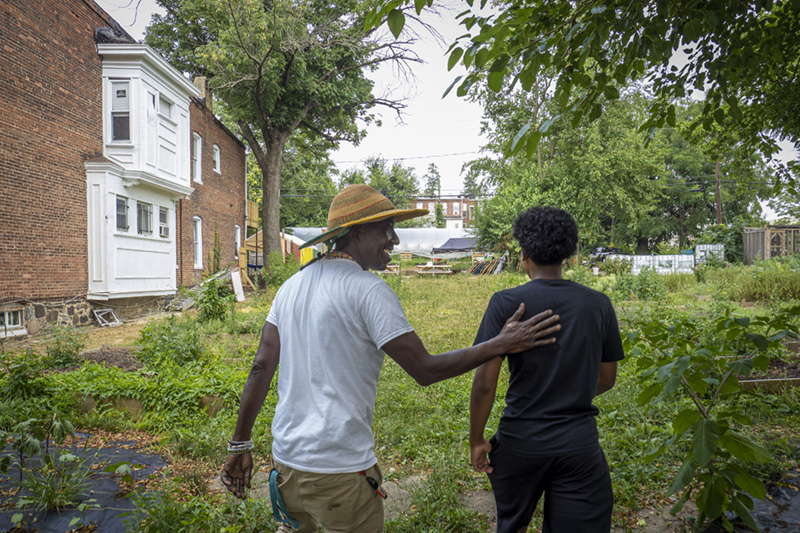
Penniman and her farm team conducted multiple customer surveys and listening sessions in several Albany, N.Y., neighborhoods and also interviewed fellow farmers who were already serving low-income communities. They found that the largest barriers to food access for low-income consumers included cost, lack of transportation and lack of accessible markets selling local, fresh, nutritious food. They also learned that farmers can overcome these barriers using a variety of strategies including community outreach and relationship building, community and nonprofit partnerships, government programs and accessible distribution approaches. For more information about lessons learned, see the project's guide, Sowing the Seeds of Justice Food Manual.
As with farmers markets, many producers find it difficult to lower the cost of their CSA shares enough to serve low-income families without suffering a loss. One possible solution is to invite existing CSA members to pay “supporting shares,” in which the member pays for their share as well as for the cost of donating a share to a low-income family. Partnerships between local nonprofits and area farmers offer another possibility, similar to how a food hub works to collaborate and improve food distribution. While a network of farmers focuses on production, a nonprofit aggregates produce and provides the capacity to manage the CSA’s marketing and distribution logistics at a lower cost because it can leverage support from grants, donors and volunteers.
VINES (Volunteers Improving Neighborhood Environments), a nonprofit in Binghamton, N.Y., offers a subsidized CSA for low-income families using this approach; along with offering different CSA share cost levels based on income, the program accepts Supplemental Nutrition Assistance Program (SNAP) benefits. VINES provides two-way education as well. Staff share recipe suggestions and tips on how to store and cook produce with members, and the nonprofit received a SARE grant in 2015 (ONE15-241) to provide technical training for its farmer collaborators. The training sought to improve the overall efficiency and profitability of their shared model.
Resources
Talk with other farmers and educators–both in person and on social media–about local community-building opportunities and groups. Also review the list of more than 100 grassroots organizations that comprise the National Sustainable Agriculture Coalition: https://sustainableagriculture.net/about-us/members.
